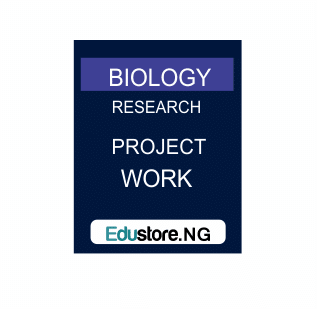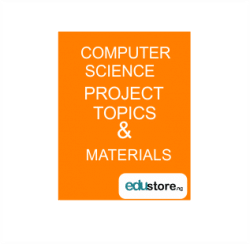Impact Of Teaching, Planning On Students Achievement In Biology
Abstract
The total population for the study is 200 staff of selected secondary schools in Egor Local Government Area of Edo State was selected randomly. The researcher used questionnaires as the instrument for the data collection. Descriptive Survey research design was adopted for this study. A total of 133 respondents made up principals, vice principals administration, senior staff and junior staff were used for the study. The data collected were presented in tables and analyzed using simple percentages and frequencies
CHAPTER ONE
INTRODUCTION
- Background of the study
The teaching of science in general and Biology, in particular, required the active participation of students in the teaching-learning process, to enable students to connect scientific concepts and theories to real purposes and practices in the world in which they live (Dumela,.& Bree, 2016). Unfortunately, the majority of the teachers teach Biology without engaging the learner actively during the teaching-learning process. (Okoli &Azubuike, 2012: Ibe, 2015). Students’ poor performance in external examinations could be as a result of poor teaching strategies and neglecting of students’ learning styles. However, different teaching strategies have been introduced but could not improve the achievement of students in Biology. Teaching and planning are different ways employed by a teacher to impart knowledge to the learners. It is also disheartening to note that, in spite of the much focus on teaching strategies in science, students’ performance in science subjects particularly Biology have continued to record a persistent and depressing downward trend ((Ikitde, & Edet, 2013: Okoli &Azubuike, 2012) [9, 11] . Several factors have been identified as affecting students’ achievement, these factors include inadequate laboratory equipment, inadequate science teachers, lack of science textbooks, poor teaching strategies amongst others but the neglected variables is learning the style. It is believed that effective learning takes place when the interactive process is one that is best suited to the individual students in terms of learning styles (Ikitde, & Edet, (2013). Learning styles (Visual / Verbal, Active / Reflective, Sensing / Intuitive, and Sequential / Global learning styles) are different approaches or ways of learning by students (Akinbobola, 2015: Fayombo, 2015; Dumela. 2016). Active learners tend to retain and understand information best by doing something active with it discussing or applying it or explaining it to others. While Reflective learners prefer to think about it quietly first. Sensing learners tend to like learning facts; intuitive learners often prefer discovering possibilities and relationships. Sensors often like solving problems by well-established methods and dislike complications and surprises; intuits like innovation and dislike repetition. Visual learners remember best what they see, pictures, diagrams, flowcharts, timelines, films etc. Verbal learners get more out of words. They prefer written and spoken explanations. Sequential learners tend to gain understanding in linear steps, with each step following logically from the previous one. Global learners tend to learn in large jumps, absorbing material almost randomly without seeing connections, and then suddenly “getting it.” Sequential learners tend to follow logical stepwise paths in finding solutions; global learners may be able to solve complex problems quickly or put things together in novel ways once they have grasped the big picture, but they may have difficulty explaining how they did it. In this study, the effect of individual students learning styles on achievement in Biology was investigated. However, the theory of multiple intelligence suggests that there are a number of distinct forms of intelligence that each individual possesses in varying degrees. According to Howard Gardner (1995), the implication of the theory is that teaching and learning should focus on the particular intelligence of each learner. For example, if an individual has strong spatial or musical intelligence, they should be encouraged to develop these abilities. Gardner (1995) points out that the different intelligence represents not only different content domains but also learning modalities/learning styles
- STATEMENT OF THE PROBLEM
To overcome these problems of students’ poor performance, there is need to strive for a balance of effective instructional strategies for science subjects such as demonstration, guided enquiry and lecture to students’ individual learning styles (Visual/Verbal, Active/Reflective, Sensing/ Intuitive, and Sequential/Global). If the balancing is achieved, it is hoped that all students will be taught in a manner they prefer which will lead to an increased comfort level to learn, and high achievement. It is against this background that the researchers sought to investigate impact of teaching, planning on student’s achievement in biology
- OBJECTIVE OF THE STUDY
The objectives of the study are;
- To ascertain the impact of teaching, planning on students achievement in biology
- To ascertain the teaching method and academic performance of student in Biology
- To ascertain the causes of poor performance of student in Biology
- To ascertain whether teacher’s qualification affect student performance in Biology
- RESEARCH HYPOTHESES
For the successful completion of the study, the following research hypotheses were formulated by the researcher;
H0: there is no impact of teaching, planning on student’s achievement in biology
H1: there is impact of teaching, planning on student’s achievement in biology
H02: there is no relationship between teaching method and academic performance of student in Biology
H2: there is relationship between teaching method and academic performance of student in Biology
- SIGNIFICANCE OF THE STUDY
This study will give a clear insight on impact of teaching, planning on student’s achievement in Biology. The study will be beneficial to students, teachers and educational sector. The study will come with strategies on how to teach biology to understandably of students. It will also serve as a reference to other researchers that will embark on this topic
- SCOPE AND LIMITATION OF THE STUDY
The scope of the study covers impact of teaching, planning on student’s achievement in biology. The researcher encounters some constrain which limited the scope of the study;
- a) AVAILABILITY OF RESEARCH MATERIAL: The research material available to the researcher is insufficient, thereby limiting the study
- b) TIME: The time frame allocated to the study does not enhance wider coverage as the researcher has to combine other academic activities and examinations with the study.
- c) Organizational privacy: Limited Access to the selected auditing firm makes it difficult to get all the necessary and required information concerning the activities.
1.7 DEFINITION OF TERMS
TEACHING: The objective is typically accomplished through either an informal or formal approach to learning, including a course of study and lesson plan that teaches skills, knowledge or thinking skills. Different ways to teach are often referred to as pedagogy.
STUDENT ACHIEVEMENT: Student achievement means improving academic outcomes for all students to ensure their success in school and life.
BIOLOGY: Biology is the natural science that studies life and living organisms, including their physical structure, chemical processes, molecular interactions, physiological mechanisms, development and evolution
1.8 ORGANIZATION OF THE STUDY
This research work is organized in five chapters, for easy understanding, as follows
Chapter one is concern with the introduction, which consist of the (overview, of the study), historical background, statement of problem, objectives of the study, research hypotheses, significance of the study, scope and limitation of the study, definition of terms and historical background of the study. Chapter two highlights the theoretical framework on which the study is based, thus the review of related literature. Chapter three deals on the research design and methodology adopted in the study. Chapter four concentrate on the data collection and analysis and presentation of finding. Chapter five gives summary, conclusion, and recommendations made of the study
ORDER FULL WORK
DOWNLOAD COMPLETE WORK- For Reference Only: Materials are for research, citation, and idea generation purposes and not for submission as your original final year project work.
- Avoid Plagiarism: Do not copy or submit this content as your own project. Doing so may result in academic consequences.
- Use as a Framework: This complete project research material should guide the development of your own final year project work.
- Academic Access: This platform is designed to reduce the stress of visiting school libraries by providing easy access to research materials.
- Institutional Support: Tertiary institutions encourage the review of previous academic works such as journals and theses.
- Open Education: The site is maintained through paid subscriptions to continue offering open access educational resources.






